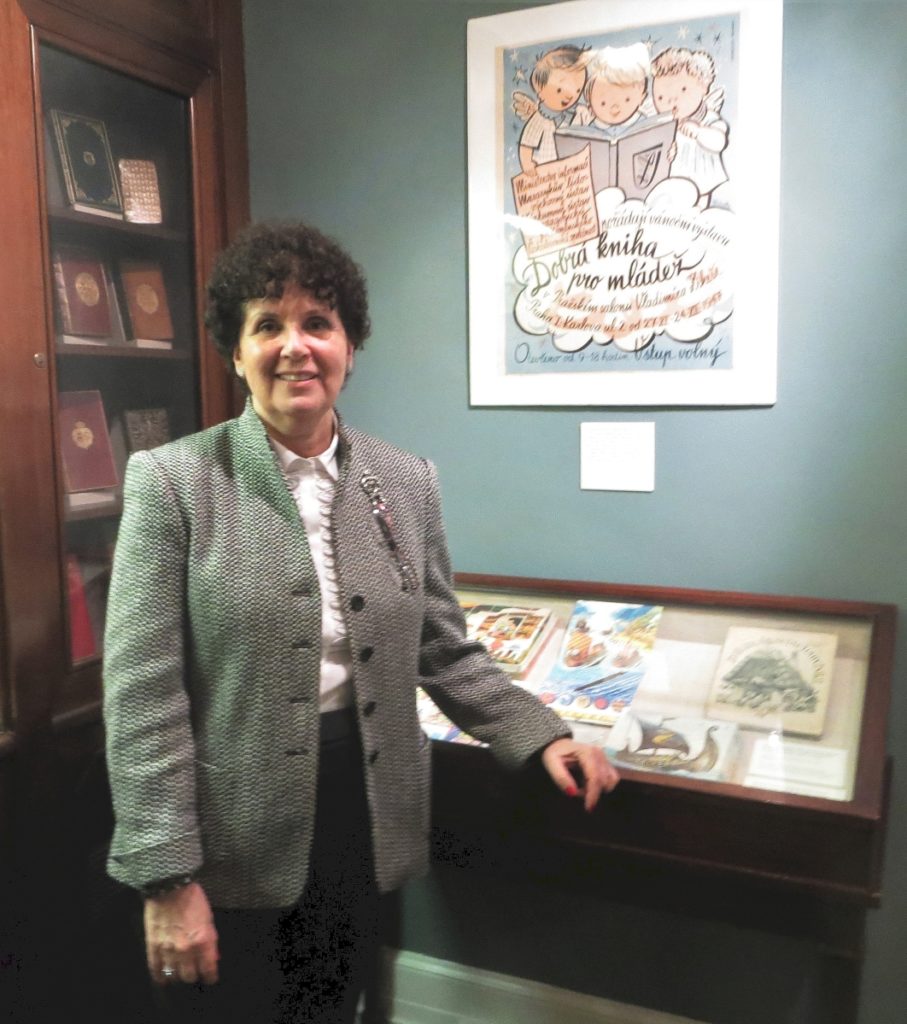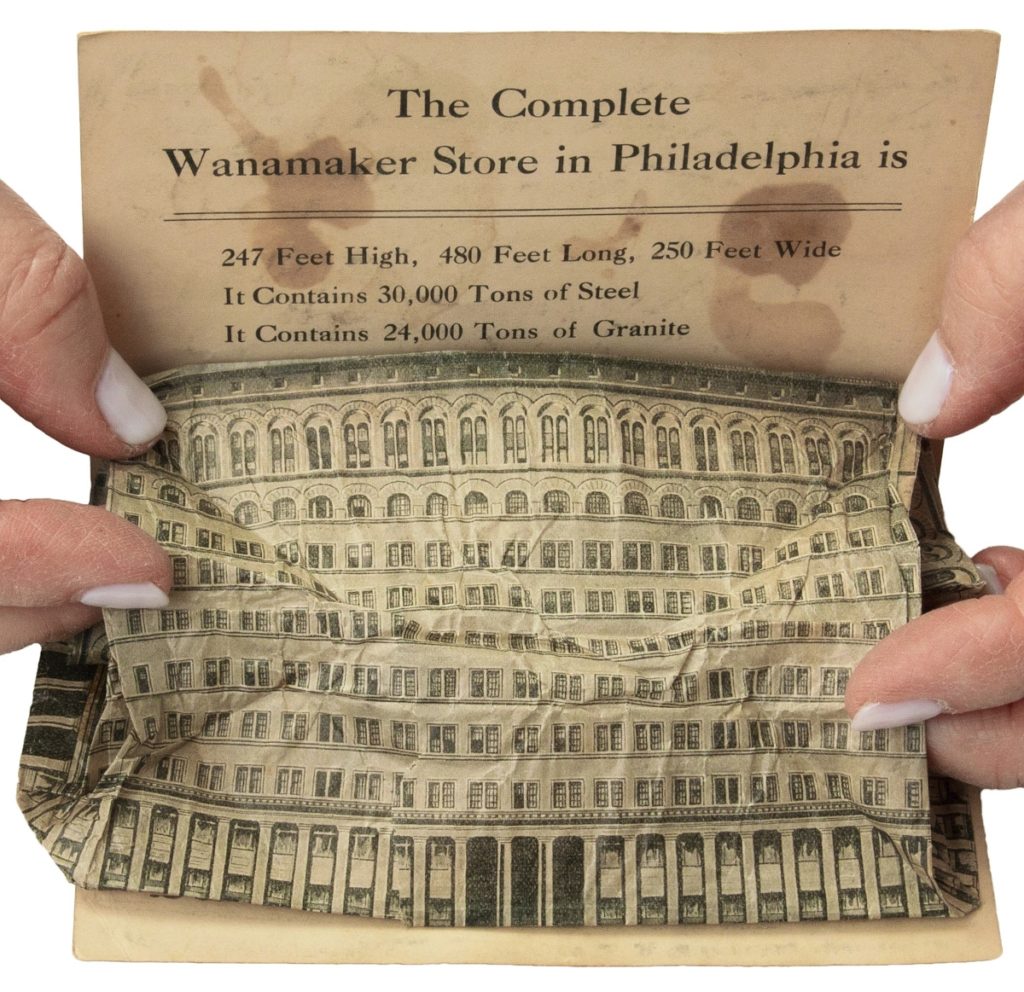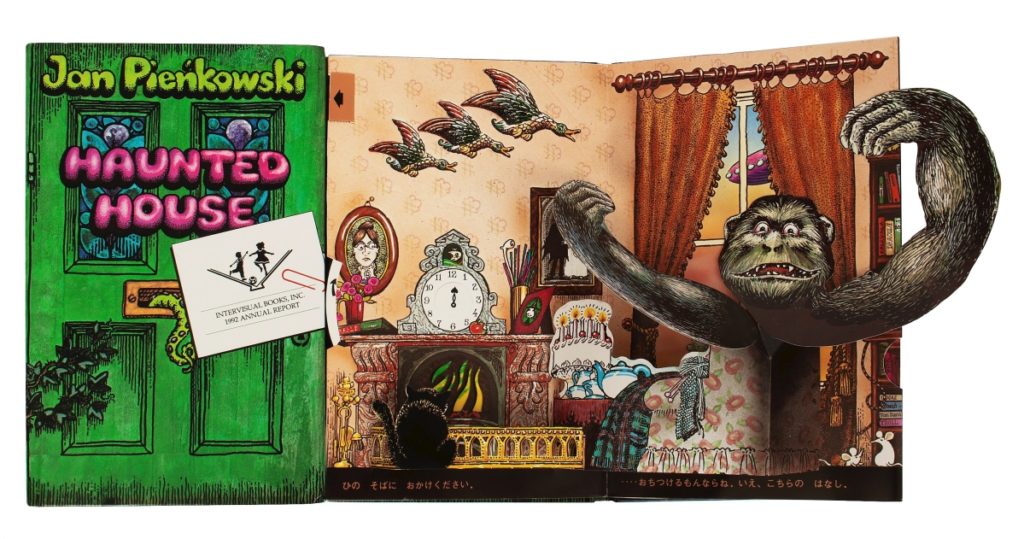
Ellen G.K. Rubin, at her 2014 Grolier Club exhibition “Pop-ups from Prague: A Centennial Celebration of the Graphic Artistry of Vojtech Kubašta (1914-1992).”
Ellen G.K. Rubin, also known as “the Pop Up Lady,” has been collecting pop-up and moveable books for more than four decades, building a library that began with the books she read to her sons as children. That collection has since grown to thousands of volumes in multiple languages that Rubin uses to educate others about these works of literary art, which are not just for young readers. Rubin is a founding member of the Moveable Book Society and also serves on its board. A member of the Grolier Club, Rubin curated its upcoming exhibition “Animated Advertising: 200 Years of Premiums, Promos and Pop-ups.” In anticipation of the exhibition’s opening on December 1, we exchanged emails with Rubin to learn more about her passion for this medium.
Please tell our readers how the ‘Animated Advertising’ exhibition came to be.
As a collector of pop-up and movable books and ephemera for more than 40 years, I always want to “shop and share.” It gives me great pleasure to show my collection and watch the “smile effect” and the “wows!” when people experience the creativity, art and ingenuity of paper engineers who make the illustrations animated and dimensional. Second best to holding the books in one’s hands is seeing them in an exhibition. I’ve done exhibitions on the history of pop-ups, “Ideas in Motion” (Sojourner Truth Library, CUNY-New Paltz, 2005); “Brooklyn Pops Up!” (Brooklyn Public Library, 2000); “Pop! Splash! Hoot! Slither! Growl! Nature in Pop-up Books” (South Fork Nature Museum, Bridgehampton, N.Y., 2015); “Fold, Pull, Pop, and Turn” (Smithsonian Library, 2010); and “Pop-ups from Prague: A Centennial Celebration of the Graphic Artistry of Vojtech Kubata (1914-1992),” (Grolier Club, 2014); among others.
When it occurred to me that some of the most complex and original mechanicals were in the advertising material, I thought to do “Animated Advertising.” The earliest piece in the exhibit is from 1824. The exhibits are teaching moments where I get to tell visitors that pop-ups did not start in 1970 when there was a resurgence of the genre, that they began not for children but for scholarly exposition for adults, and most startling is that every book or piece of ephemera with movable paper parts is handmade, even today. The catalogs that accompany most of the exhibits are also teaching tools with histories and glossaries of the terms most people are unfamiliar with.
Is there a connection between pop-up advertising of past centuries and today’s marketing?
Just as the advancement in printing affected paper advertisements, making them more abundant and easier to produce, some of today’s paper ads are more complex with microchips adding sound and lights. Regulators, like the FDA for example, have impacted the message, but the goal is the same, get the message in front of the target user and have them remember it. The interactivity of movable and dimensional ads helps the recipient retain the message. Also, today’s ads appeal more to subtle and psychological values than in the Nineteenth Century. Sex has always sold but today’s ads are more direct. Historically, when literacy was low, one would think the graphics would have played a bigger part in the message than the text. Yet today the appeal of the graphics remains an important and integral part of the communication, still the first attraction to the advertisement.

The earliest book in Rubin’s collection, De sphaera mundi by
Johannes de Sacrobosco (circa 1195-1256), printed in 1547.
How did these fragile materials survive to the present day?
Survival! This is what astounds me almost above all else. It is nothing short of amazing that ephemeral paper, things intended to be thrown away after use, were held through generations. While the late Nineteenth Century was a time of avid scrapbooking and many advertisements in my collection bear glue scars, I can’t say what made someone hold onto an ad for a kidney medication or an automotive cigarette lighter? I have to think the bright graphics, sometimes comical message, and the novelty of the interactive parts are big contributors. I really don’t have a definitive answer but enjoy the conundrum.
What is it about movable and pop-up books that captivates you most?
I was an avid reader as a child and liked to be crafty, cutting and gluing, sewing and knitting. Here were books that required interactivity. In order to fully appreciate the text, idea or illustrations, one must participate. I think of the paper engineers, those artists who animate the illustrations, as puppeteers who hand the strings to us, and we create the action.
While I can trip over myself repeating “this is my favorite,” one of the two most fascinating objects in the exhibit is the John Wanamaker postcard created when the new store opened in Philadelphia (circa 1910). On the address side is printed “blow here.” When you do, a crepe paper replica of the store inflates on the verso. A real hoot! And to think that so many of these complex movables survived going through the mail.
The other object is the Toyota Camry ad of 2021, created by Structural Graphics, the premier company producing dimensional advertising. As if it was not enough for the ad, inserted into select copies of InStyle magazine, it has a new car smell. When one puts one’s thumbs on the “door handles” and opens the triptych, the dashboard lights up and the user’s own EKG crosses the screen! Beyond awesome. Grabs one’s attention and displays the attributes of the car simultaneously! One might say this is a perfect advertisement.

Advertisement for Wanamaker Store, Philadelphia, circa 1910. —Nicole Neehan photo
How many volumes do you have in your collection, and which was the object that started it all?
I have cataloged my books from the beginning, so I know I have more than 11,000 objects. But I did not start cataloging the ephemera until a few years ago and now have filled 32 5-inch, three-ring binders. There must be thousands. Included in the count are pieces of original artwork from which the books are made. They are the hardest of all to come by and among my favorites.
The two objects that started it all were the Random House books of Trucks and Dinosaurs (1974) bought for my two young sons. I was immediately taken with the interactivity and the life-like movements and decided to collect them. My thought was to collect children’s literature and science, since that is my field, but when I attended the Yale Medical School’s Physician Associate program in 1987, I visited the exhibit “Eccentric Books,” which were all movable and dated back to the Sixteenth Century. I was really hooked then to think of the history associated with the genre.
You have a Wish List on your website, what would be your “Holy Grail?”
I’ve been fortunate in my collecting with my earliest book being the Sacrobosco Sphaera, from 1547. But I would love to have an incunable [a book, pamphlet or broadside printed before 1500]. The pinnacle of movable books would be the 1540 Astronomicum Caesareum by Apianus with 35 volvelles and considered the most beautiful movable book ever printed. Rare, to say the least, especially complete with pearls on the strings; it now can sell for upwards of $1.25 million.

Haunted House by Jan Pienkowski, published by Intervisual Books, 1992. —Nicole Neehan photo
In an increasingly digital world, what do you predict for the future of movable books and ephemera?
Despite the higher cost of creating dimensional books and ephemera, people still want the tactile sensation of paper. The interactivity and involvement with movables will keep them attractive. Today, more and more artists are incorporating animated elements into their artist books. Pop-up and movable elements are still being introduced into books, and they are not just for children.
It pains me to think that it will be near impossible for digital art or ephemera to be saved for future study. As I say in the exhibit catalog, I find these objects exciting in their creativity, clever in their messages, and staggering in their survival. It pains me to think how this digital age will rob the future. Without these corporeal examples, what material will there be to maintain and study?
[“Animated Advertising: 200 Years of Premiums, Promos and Pop-ups” will be accompanied by a 112-page color catalog, available through the Grolier Club, which is at 47 East 60th Street. For information, 212-838-6690 or www.grolierclub.org.]
-Z.G. Burnett




